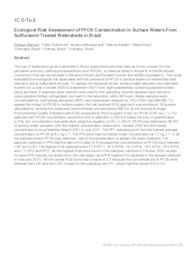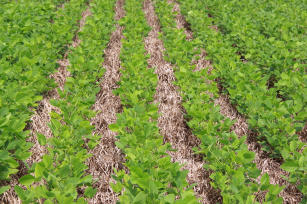Ecological risk assessment of PFOS contamination in surface waters from sulfluramid-treated watersheds in Brazil.
Ecological risk assessment of PFOS contamination in surface waters from sulfluramid-treated watersheds in Brazil.
Autoria: BARIZON, R. R. M.; KUMMROW, F.; ALBUQUERQUE, A.; ASSALIN, M. R.; ROSA, M. A.
Resumo: The use of sulfluramid as an insecticide in Brazil poses environmental risks as it mayconvert into the persistent and toxic perfluorooctanesulfonic acid (PFOS), a chemical listed inAnnex B of the Stockholm Convention that can accumulate in the environment and threaten humanand wildlife populations. This study evaluated the ecological risk associated with the presence ofPFOS in surface waters of watersheds with intensive use of sulfluramid ant bait. To assess theexposure levels, surface water samples were sampled monthly for a year (October 2020 toSeptember 2021) from eight watersheds containing planted forests using ant baits. A stainless-steelcollector was used for the sampling, and the samples were stored in polypropylene bottles,refrigerated, and sent to the laboratory within 48 hours. Water samples were concentrated by solidphase extraction (SPE) and subsequent analysis by UPLC-ESI-QqQ-MS/MS. To assess the impactof PFOS in surface waters, the risk quotient (RQ) approach was employed. RQs were calculated bydividing the measured environmental concentrations (MECs) by the Annual AverageEnvironmental Quality Standard (AA-EQS) proposed by the European Union for PFOS (0.65 ngL?1). For samples with PFOS concentration above the limit of detection (LOD) but below the limitof quantification (LOQ), the concentration was estimated using the equation (LOQ + LOD)/2.PFOS was detected in 85.3% of surface water samples, with the highest concentration observed inOctober 2020 and the lowest concentrations found between March 2021 to July 2021. The PF1sampling point had the highest average concentration of PFOS at 8.2 ng L-1. The PF6 point hadthe lowest mean concentration at 1.5 ng L-1. In all the samples where PFOS was detected, risks tothe preservation of aquatic life were observed. The samples collected in PF6 had the same RQvalue (2.3) because the concentrations of PFOS were between LOD and LOQ. The highest RQsobtained were 77.8 (PF1), 20.5 (PF8), 19.2 (PF4), 18.9 (PF5), 18.5 (PF3), and 7.7 (PF2 and PF7).All the highest RQs were found in the samples collected in October 2020, except for sites PF6(sample not analyzed in this campaign) and PF8 (highest RQ obtained in the sample collected inFebruary 2021). All the lowest RQs found had a value of 2.3 because the concentrations of PFOSwere between the LOD and the LOQ, except for the sampling site PF1, which had the lowest RQof 3.4.
Ano de publicação: 2023
Tipo de publicação: Resumo em anais e proceedings
Unidade: Embrapa Meio Ambiente
Palavras-chave: Contaminação, Groundwater contamination, PFOS, Perfluorooctanesulfonic acid, Risk assessment, Águas Superficiais
Observações
1 - Por padrão são exibidas publicações dos últimos 20 anos. Para encontrar publicações mais antigas, configure o filtro ano de publicação, colocando o ano a partir do qual você deseja encontrar publicações. O filtro está na coluna da esquerda na busca acima.
2 - Para ler algumas publicações da Embrapa (apenas as que estão em formato ePub), é necessário ter, no celular ou computador, um desses softwares gratuitos. Sistemas Android: Google Play Livros; IOS: iBooks; Windows e Linux: software Calibre.
Acesse outras publicações
Acesse a Base de Dados da Pesquisa Agropecuária (BDPA) para consultar o acervo completo das bibliotecas da Embrapa.


